Leiomyoma of the Cheek
Abstract
Leiomyomas are rare benign tumors that grow in the tunica media of smooth muscle cells. Leiomyomas occur most frequently in the uterus or gastrointestinal tract and only very rarely in the area of the cheek. This study reports on a rare case of a leiomyoma in the cheek of a 43-year-old woman, who presented with a well-circumscribed, asymptomatic, mobile swelling in the right cheek. This swelling was slightly purplish in color and measured approximately 4 cm × 3 cm. Surgical excision was the treatment of choice, and the diagnosis was based on histopathological and immunohistochemical stains, which were positive for actin and desmin and negative for AE1/AE3, CD34, and S100. The patient’s follow-up, two years later, showed no recurrence, and she has been asymptomatic since the surgery.
1. Introduction
Leiomyomas are benign mesenchymal tumors arising from nonepithelial tissues, such as smooth muscle [1, 2]. These tumors are well-circumscribed neoplasms that are encountered frequently in the dermis, the gastrointestinal tract, and the female genital tract, in particular, the uterus [3, 4]. As smooth muscle cells are relatively rare in the oral cavity, in comparison with the gastrointestinal tract, oral leiomyomas are extremely rare, with an incidence of less than 1% of all benign, soft tissue tumors [5]. Leiomyomas are neoplasms which develop due to mutation that results in the loss of the growth regulation mechanisms of the smooth muscle cells [5, 6]. The development of this benign tumor depends on a complex interaction between hormones (estrogen, progesterone), growth factors, and cytokines, as well as genetic predisposition [7, 8]. The risk factors include middle age (fourth to sixth decades of life), dark skin, women with a history of chronic disease, including recurrent gynecological infections, and a high body mass index [9]. Leiomyomas are manifested clinically as slow-growing, asymptomatic lesions that are well-circumscribed and often purplish in color [10, 11]. Histologically, three types of leiomyoma can be distinguished: (a) leiomyoma (solid leiomyoma), (b) angioleiomyoma (vascular leiomyoma), and (c) epithelioid leiomyoma (leioblastoma) [12, 13]. The clinical aspects of leiomyomas are indistinguishable from other tumors located in the tongue or in the cheek, including pleomorphic adenomas, lymphangioma, pyogenic granulomas, and schwannomas [14, 15]. Diagnosis is based on histopathological examination, and surgical excision is the treatment of choice, with recurrence being extremely rare [16, 17]. The present study describes a rare case of a leiomyoma in the cheek of a 43-year-old woman.
2. Case Report
A 43-year-old woman, a nonsmoker, with no medical antecedents was referred to the Departments of Oral and Maxillofacial Surgery of a dental college in northern Brazil for evaluation of a well-circumscribed, solitary, asymptomatic, mobile mass in the right cheek, which was slightly purplish in color, causing facial asymmetry (Figures 1(a) and 1(b)).
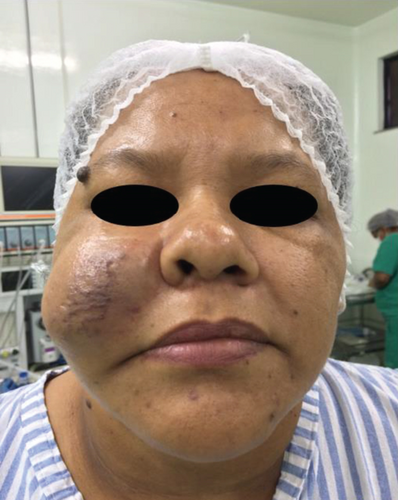
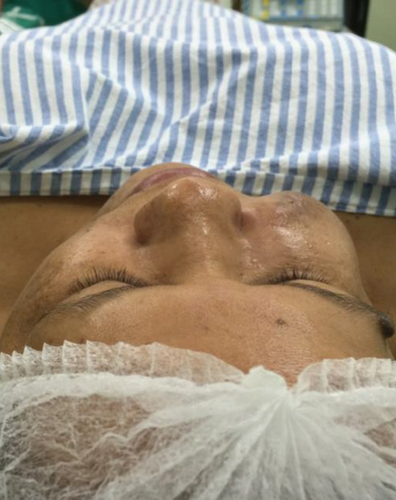
The patient reported having had a swelling in the right cheek over the previous two years. She also reported that she was not on any drug therapy and did not consume alcohol regularly. Physical and oral examination revealed a well-demarcated, palpable, hard elastic mass measuring approximately 4 cm × 3 cm, located in the submucosal layer of the right cheek. The overlying mucosa appeared clinically normal and was not ulcerated. A CT scan revealed a homogenous mass with well-defined margins and no evidence of maxillary sinus infiltration or bone resorption (Figures 2(a) and 2(b)).

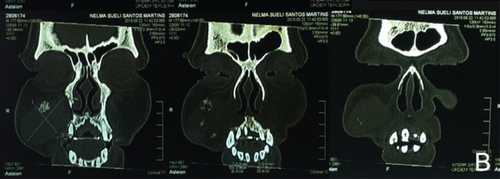
The patient underwent an excisional biopsy (Figure 3). Microscopic examination revealed uniform spindle-shaped cells with elongated nuclei, eosinophilic cytoplasm; several blood vessels lined with a thin layer of endothelial cells were embedded within the lesion (Figure 4(a)). Immunohistochemical stains with monoclonal antibodies against actins, desmin, vimentin, cytokeratins AE1/AE3, CD34, and the S100 protein (Figure 4(b)) were performed. Stains for vimentin, desmin, muscle-specific actin, and smooth muscle actin were positive while stains for cytokeratins AE1/AE3, EMA, S100, and CD34 were all negative in the tumor cells. The histopathological diagnosis was leiomyoma of the cheek. The follow-up examinations over 2 years after the procedure showed no evidence of recurrence (Figures 5(a), 5(b), and 6).
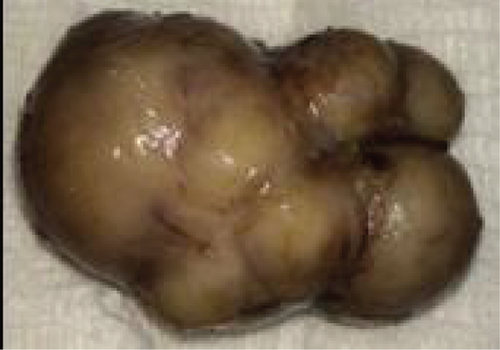
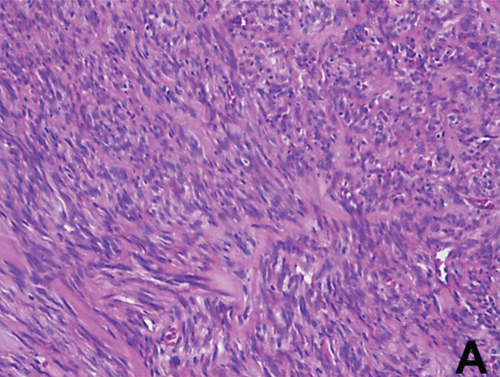
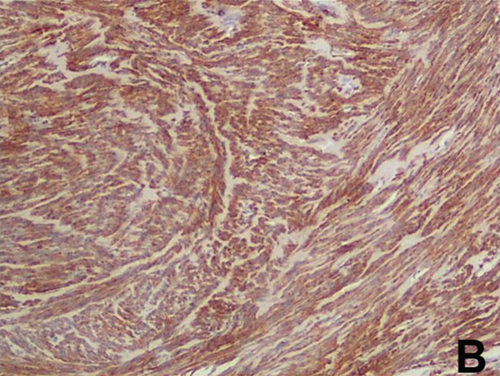


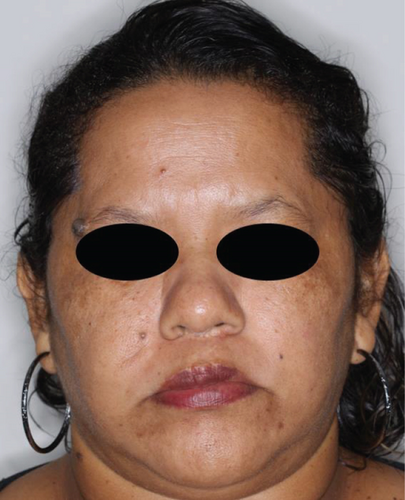
3. Discussion
Baden et al. described leiomyomas as a benign neoplasm that arises in the smooth muscle [18, 19]. As reported in several previous reports [18–28], leiomyomas can be found in areas with an abundance of smooth muscle, such as the uterine or gastrointestinal tracts and the dermis. Given the lack of smooth muscle in the oral cavity, in particular in the cheek, palate, or tongue, the only available substrates in this area would be blood vessels, circumvallate papillae, and heterotopic smooth muscle [20]. The pathogenesis of leiomyoma in the oral cavity is unclear, although oral trauma, venous stasis, hormonal changes, and genetic alterations can be implicated [20, 21].
Previous studies [22–24] have reported leiomyomas of the oral cavity primarily in the lips, followed by the palate, the buccal space, the mandible, the tongue, and the gingiva, while the cheek is the least frequent site of leiomyomas in the oral cavity [25, 26]. Given this, the case of leiomyoma reported here in the cheek of a 43-year-old female can be considered to be relatively rare. The exceptional nature of the present case is reinforced by the fact that most cases of leiomyoma in the oral cavity are relatively small, that is, typically less than 2 cm in diameter, nodular, and slow-developing. The cheek leiomyoma described in the present study was larger than any benign smooth muscle tumor reported previously [27, 28]. Clinically, it is difficult to distinguish leiomyomas of the cheek from other lesions or tumors of the oral cavity, such as pleomorphic adenoma, lymphangioma, fibroma, lipoma, or pyogenic granuloma [20–24]. However, angioleiomyomas, unlike leiomyomas, appear reddish blue in color and are soft and compressible on palpation. The benign characteristics of leiomyomas include the absence of mitoses and necrosis, as well as cellular atypia and pleomorphism in histopathological evaluation [25–28]. The diagnosis of leiomyoma is based on positivity for desmin, smooth muscle actin, and muscle-specific actin and negativity for the S100 protein [28].
Leiomyomas recur only very rarely, although prognosis depends on the completeness of the surgical excision of the tumor. In one case, an angioleiomyoma was excised from the region of the hard palate, but 9 weeks after the first procedure, the authors noted the recurrence [27]. In the second case of an angioleiomyoma in the region of the hard palate, recurrence was noted two weeks after the first excision [28].
4. Conclusion
A leiomyoma of the cheek is a rare benign neoplasm. We report a case of a leiomyoma located in the buccal mucosa of the oral cavity. Tumors of this type are asymptomatic and may develop for months or even years. The diagnosis of this lesion requires histopathological evaluation.
Consent
Appropriate consent was obtained to include images of the patient in the publication.
Conflicts of Interest
The authors declare having no potential conflicts of interest with respect to the research, authorship, and/or publication of this article.




